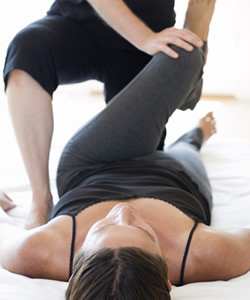Pelvic Floor Therapy
 Pelvic floor therapy is very different than what you might expect. It focuses on movement and muscle health rather than medication. If weakness is the issue, the goal is to strengthen muscles. If tension is the problem, the goal is to relax the muscles, restore proper length & position and to eliminate any painful muscle knots (aka trigger points).
Pelvic floor therapy is very different than what you might expect. It focuses on movement and muscle health rather than medication. If weakness is the issue, the goal is to strengthen muscles. If tension is the problem, the goal is to relax the muscles, restore proper length & position and to eliminate any painful muscle knots (aka trigger points).
The success of physical therapy in reducing pelvic pain is proven. In two large, nationwide randomized multicenter studies which compared the effectiveness of myofascial physical therapy vs. simple therapeutic massage, MPT was found to be more helpful in reducing symptoms of IC.(1)(2)
The challenge, however, may lay in your willingness to do the exercises at home. Visiting a physical therapist once a week is simply not enough. Within hours, that tension may return. Thus, the patient must work on a daily basis at recognizing tension and in doing exercises and stretches that will release the tension.
Pelvic Floor Dysfunction Treatments
Self-Help
Self-help is the cornerstone of success. In Step One of the AUA Guidelines for IC/BPS, pelvic floor relaxation exercises are strongly suggested. Taking warm baths daily can help relax tight muscles. It’s important that you not STRAIN or PUSH when urinating or defecating. If you struggle with constipation, please talk with your physician to discuss appropriate treatment.
Physical therapy
Many urology clinics now have physical therapists on staff who are trained in pelvic floor rehabilitation. In general, they will provide manual “hands” on therapy (internally and externally) and will give you a exercises to take home and use daily. Physical therapy takes patience and time. Because the musculature is often sensitive, the physical therapist often starts very slowly to carefully retrain those muscles. Patients generally start seeing improvement after six to eight weeks.
If you cannot afford physical therapy, it might be helpful to see a physical therapist just once or twice a year for exercise suggestions and an update. If that isn’t possible, we strongly suggest that you purchase some of the books and/or CD’s that can help guide you for self-care at home.
Looking for a physical therapist? Try searching the ICN Find A Specialist Database!
Medication
For extreme tension, physicians may prescribe a low dose muscle relaxation to calm the muscles, such as diazepam (Valium), Flexeril or Baclofen. Vaginal valium suppositories are also commonly used to reduce pelvic floor tension, particularly activities that increase tension such as intimacy.
Acupuncture & Yoga
Both Acupuncture and Yoga have been found to be somewhat helpful in reducing PFD though no formal research studies have proven their success. Nevertheless, you’ll find physical therapists around the country who incorporate them into their treatment protocol.
Useful Articles, Blogs & Videos
There are several outstanding resources online for patients struggling with PFD. Here are some resources that we think are exceptionally good.
- Ten Common Misconceptions About Pelvic Physical Therapy – Pelvic Guru
- What is the Patient’s Role During Pelvic Floor PT – Pelvic Health & Rehab (San Francisco, CA)
- Can Yoga Help My Pelvic Pain – Pelvic Health & Rehab (San Francisco, CA)
- Stuck on Acupuncture (Part 1)
- Stuck on Acupuncture (Part 2)
- Dilators and the Brain? Pain, Fear and Anxiety
Books & CD’s
There are several good books that will help patients understand more about the pelvic floor dysfunction, the anatomy of the pelvis and stretches and exercises that you can do at home that may help.
- Breaking Through Chronic Pelvic Pain: A Holistic Approach To Relief
- Interstitial Cystitis Solution
- Heal Pelvic Pain:
- Ending Female Pain
References
(1) Fitzgerald MP, et al. Randomized multicenter clinical trial of myofascial physical therapy in women with interstitial cystitis/painful bladder syndrome and pelvic floor tenderness. J Urol. 2012 Jun;187(6):2113-8.
(2) Fitzgerald MP, et al. Randomized multicenter feasibility trial of myofascial physical therapy for the treatment of urological chronic pelvic pain syndromes. J Urol. 2009 Aug;182(2):570-80.
